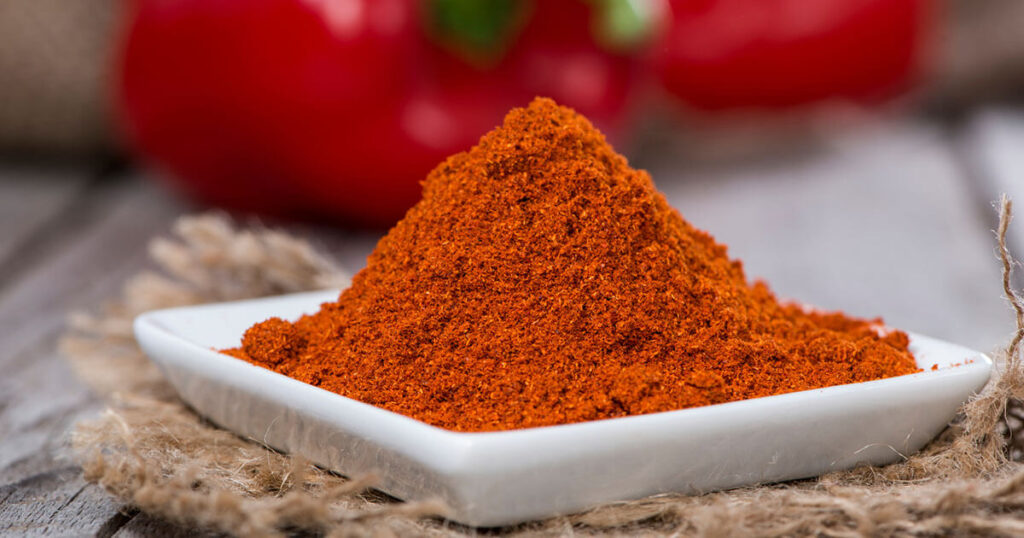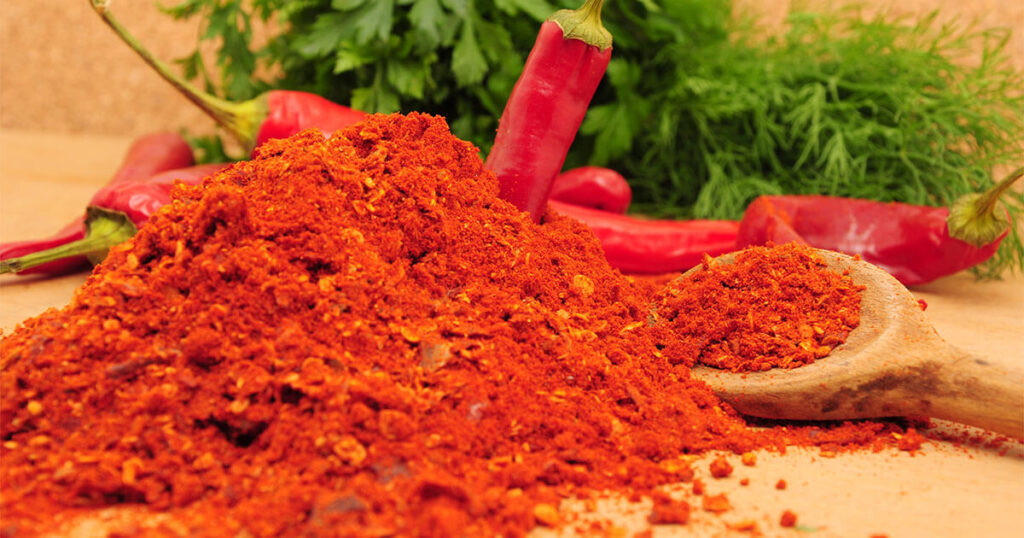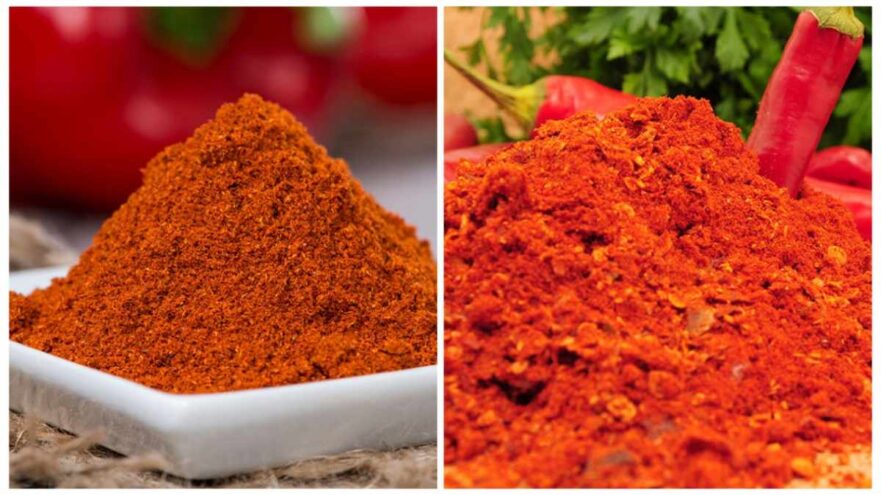Peppers are widely recognized for their ability to enhance the flavor and complexity of a dish, with different varieties catering to different culinary needs. Paprika and cayenne powder are two of the most well-known pepper-based spices. In this article, we will look at the distinct characteristics of each of these spices and their origins, flavors, culinary applications, and health benefits to help you choose the best spice for your dish.
Table of contents
What is Paprika?

Paprika is a well-known spice, distinguished by its bright red color and distinct flavor. It’s made with a ground dried bell or chili peppers. Despite its origins in Central and South America, it was popularized in Hungarian and Spanish kitchens.
Hungary, for example, has a diverse range of paprika flavor varieties. They have eight, to be exact. These variations range from milder, sweeter versions to those with a fiery kick. Hungarian paprika is ready to step up, whether you’re making a rich goulash, stew, or a gravy pörkölt.
On to Spain, where “pimentón,” their version of paprika, holds its own. What makes it unique? That distinctive smoky twist. This flavor is due to the drying process of oak wood. This paprika lends a distinctly Spanish flavor to paellas, tapas, and various meat dishes.
Paprika has health benefits in addition to its culinary appeal. It’s high in antioxidants and vitamins, including vitamin A, which is great for skin and eye health, and vitamin E, your trusted ally in the fight against oxidative stress. So, the next time you reach for a jar of paprika, know that you’re also grabbing a dash of history, culture, and well-being.
What is Cayenne Pepper?

Cayenne powder is a spicy superstar, distinguished by its fiery red color and robust flavor. It is a member of the Capsicum annuum family and is derived from the dried and ground fruits of the cayenne pepper plant. Its origins can be traced back to the Cayenne region of French Guiana, which is not afraid of heat.
With a Scoville rating of 30,000 to 50,000, cayenne powder outperforms many of its competitors regarding heat, including most paprika varieties. This intense heat and distinct tang can be found in many dishes, including hot sauces, zesty curries, and hearty chilis.
Cayenne pepper has been seamlessly integrated into dishes from Africa’s spicy stews to India’s tangy pickles, creating culinary connections across continents. This adaptable spice graces traditional dishes as well as innovative culinary creations in modern times, reaffirming its timeless appeal in the global culinary scene.
But cayenne isn’t just for raising the temperature of your food. Its appeal extends beyond the kitchen. It has been touted for various health benefits due to its high capsaicin content. Cayenne powder has proven to be more than just a flavor enhancer, revving up the metabolism, smoothing digestion processes, and providing pain relief.
What are the similarities between Paprika and Cayenne Pepper?
In the culinary world, paprika and cayenne powder have a universal appeal. While their flavor profiles are distinct, both are used to elevate dishes by adding depth and warmth. Chefs and home cooks use them as secret ingredients to enhance sauces, stews, and marinades, providing food lovers with a more nuanced flavor palette.
Another notable similarity between paprika and cayenne powder is their nutritional composition. Vitamin A, essential for healthy vision, skin, and the immune system, is abundant in both. Furthermore, paprika and cayenne pepper contain carotenoids, specifically lutein and zeaxanthin, which are good for eye health and antioxidants. This shared abundance of vitamin A and beneficial compounds emphasizes their importance in flavor and nutrition.
Trade and globalization highlight their similarities even more. As global trade routes expanded, so did the popularity of paprika and cayenne powder outside of their native regions. These spices found their way into various cuisines, from European to Asian kitchens, demonstrating their adaptability and universal appeal.
Finally, both spices have had an impact beyond the culinary world. They’ve made a name for themselves through cultural events, festivals, and rituals. Whether it is the vibrant celebrations of paprika in Spain or the traditional uses of cayenne in various cultural ceremonies, these spices have become symbolic of the regions they represent, uniting communities.
What are the differences between Paprika and Cayenne Pepper?
While paprika and cayenne powder are red spices derived from peppers, they have distinct characteristics that set them apart. The first and most obvious difference is the intensity of the heat. Paprika can be sweet, mild, or spicy, especially in certain Hungarian and Spanish varieties. On the other hand, cayenne powder is unmistakably fiery, owing to its origins in the hotter cayenne pepper.
Another point of departure is their flavor profiles. Paprika can have a variety of flavors, ranging from earthy and slightly sweet to smoky, especially in its Spanish ‘pimentón’ form. On the other hand, Cayenne is more concerned with delivering a bold, fiery punch to dishes, making its flavor profile less complex.
Their applications in cooking amplify these distinctions. Paprika is a versatile ingredient in dishes such as Hungarian goulash, Spanish paella, and various meat rubs. Its gentle warmth and vibrant color complement without overpowering a dish. Cayenne pepper is a favorite for dishes that require a spicy kick, such as spicy Asian curries, Mexican salsas, and zesty marinades.
Their appearance also has a distinct visual distinction. While paprika is bright, sometimes orange-red, especially when made from bell peppers, cayenne has a deeper, more intense red color that indicates its spiciness.
Finally, their historical and cultural significance differ. While paprika is deeply ingrained in Hungarian and Spanish culinary traditions, cayenne powder has a more global appeal due to its origins in French Guiana’s Cayenne region and widespread use in various spicy cuisines worldwide.
FAQ about Paprika and Cayenne Pepper
Is cayenne powder spicier than paprika?
Yes, cayenne powder is more spicy than paprika. Cayenne powder has a Scoville rating ranging from 30,000 to 50,000, whereas the heat of paprika varies, with many varieties being sweet and mild.
What are the health benefits of paprika and cayenne powder?
Paprika and cayenne powder offer a plethora of health benefits. Both are abundant in vitamin A and carotenoids, which benefit vision and immune support. While paprika stands out for its vitamin A content, cayenne is notable for its capsaicin, which can aid metabolism and digestion. Together, these spices not only enhance flavor but also promote well-being.
Can I substitute one for the other in recipes?
Although both paprika and cayenne powder are made from dried peppers, they have distinct flavor profiles. Substituting one for the other can drastically alter a dish's flavor and heat level. If you're thinking about substituting, proceed with caution. Begin with less than the recipe calls for, then gradually increase based on your taste preferences. Remember that cayenne is much spicier than most paprikas, so add it gradually to avoid overpowering the dish.
How should I store paprika and cayenne powder?
Both should be stored in a cool, dark place in airtight containers, such as a pantry away from direct sunlight. Proper storage ensures they retain their flavor and potency for longer durations.
Which cuisines predominantly use paprika and cayenne powder?
Paprika is a staple of both Hungarian and Spanish cuisines. In Hungary, paprika is essential in goulash and other dishes such as pörkölt, chicken paprikash, and stuffed peppers. Over in Spain, aside from the famous paella, paprika graces dishes such as chorizo, patatas bravas, and fabada asturiana. Meanwhile, cayenne powder is popular in various global cuisines with its fiery flavor. It's a popular ingredient in Indian, Mexican, and Thai cuisines, adding a spicy kick to many dishes.
